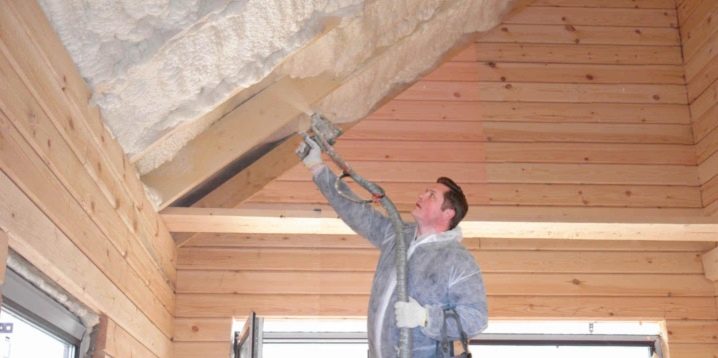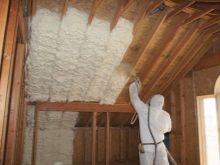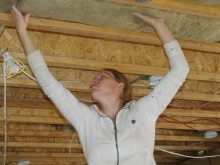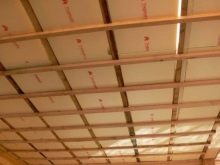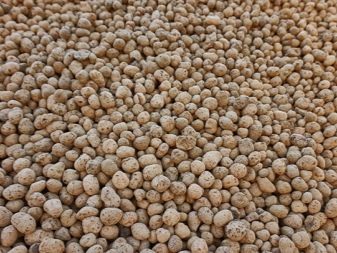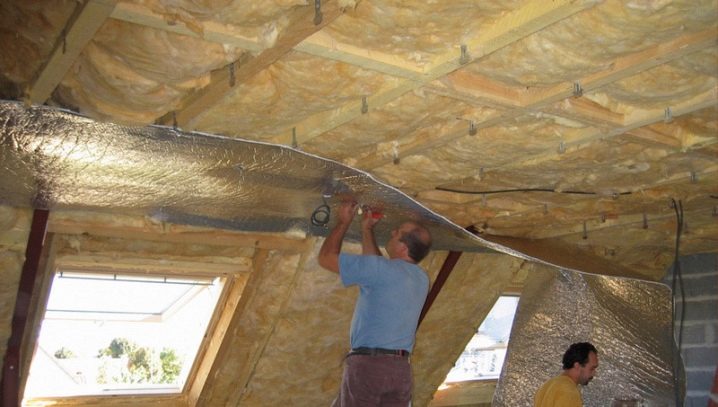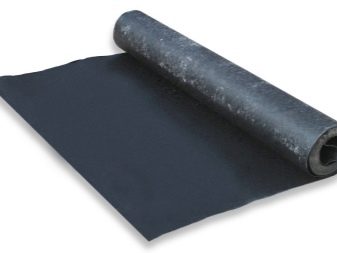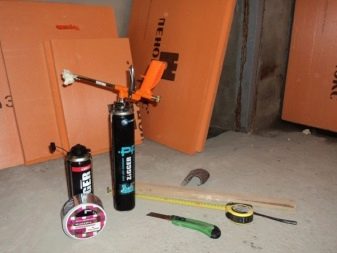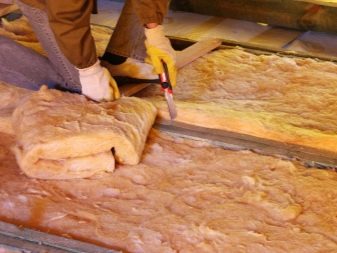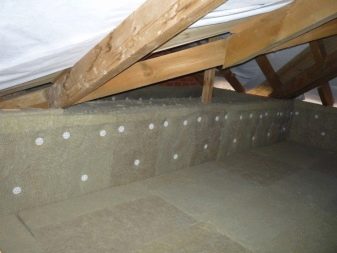The subtleties of insulation of the ceiling in a wooden house
Roof and ceiling should reliably protect the residents of the house not only from precipitation, but also from temperature changes. In itself, the tree keeps the heat quite well, and it still needs additional protection. Performing it properly can be quite difficult.
Special features
In a wooden house, it is quite logical to use wood to create ceilings: builders lay beams, planked from below. The lack of heating of the upper part of the building results in the need for its warming. And even when residential attic is equipped, insulating materials help save fuel, increase the level of sound insulation.
Warming of the ceiling from a bar in a country house can only be done properly. after elimination of defects of a wooden surface. They are closed with tow, polymer fibers or blown with foam.. You should not try to save time using different materials: regardless of their properties, to compensate for the disadvantages of the base in this way will not work. Compaction or caulking work is required to be carried out as responsibly and conscientiously as possible. The most practical solution, many experts believe jute fiber.
Wooden structures before insulation should be treated with antiseptic compounds to suppress the accelerated development of parasitic fungi and other microorganisms. In particularly difficult cases, the treatment is carried out twice to increase the effectiveness of protection.
What can be insulated?
But the importance of preparation does not mean that the choice of insulation is not significant enough.
Most often in suburban buildings used:
- mineral wool;
- expanded clay;
- expanded polystyrene and its subspecies - polyfoam;
- sawdust.
The main part of developers is actively using mineral water.which costs rather cheap and is established without excess problems, perfectly keeps consumer qualities long time.
The mineral wool layer improves the sound insulation characteristics of the floor; at the same time, moisture accumulation (with weakening of heat-insulating properties) and high sanitary risk are weak places.
Using polyfoam, it is possible to guarantee full ecological safety. Expanded polystyrene plates (this is the official name of the material) are very light, they are not very susceptible to crumbling and transmit heat even less than the usual packaging material. Under the action of water, polystyrene foam does not suffer at all and can provide excellent insulation even with relatively small thickness.
Unfortunately, expanded polystyrene burns well, and rodents often make their moves in it.
Insulation with expanded clay is also widely used in wooden houses, because this material:
- does not require significant costs;
- under favorable conditions, it works more efficiently and longer than any other;
- does not suffer from contact with water;
- not flammable and mechanically strong.
People started using sawdust much earlier than blocks of expanded clay and expanded polystyrene. This method does not harm the environment and therefore you can safely apply it even now. Any sawmill will sell the woodworking waste at an exceptionally low price, and professional builders or people who often procure firewood can collect the necessary material themselves.
But we have to reckon with the danger of fire and the fact that sawdust well retain heat only in fresh form. Once they shrivel, get wet or stagnate (lose volume), the negative consequences immediately make themselves felt.
Warming penoplex (also extruded polystyrene foam) is advisable because it is not inferior to mineral wool in its practical characteristics and is relatively inexpensive. But have to take into account the increased risk of ignition, although this is not an insurmountable obstacle in the work, you only need to use special impregnation.
To cope with high water vapor permeability helps equipment special vapor barrier layer, the creation of which must be approached with the utmost seriousness.
The same options can be used when we warm the attic floor in a private house; but it is advisable to provide the final choice to professional builders and designers, at least to consult them before buying.
Mounting methods
Arrangement of thermal insulation of ceilings in wooden houses is divided into two parts: in one case, work is carried out in the attic or attic room,opening the floor, in the other - they open the very upper part of the room and place the selected materials in it. The differences relate to the technology of work, so both options should be considered separately from each other.
Outside
When they begin to act in the attic, they insulate the base with mineral wool only after the ceiling has been filled (the cutting board is used for it). In a long-used house, there is no need to disassemble the existing ceiling and create a new one., enough over the attic floor to place a honeycomb frame. The gaps of the beams are filled with material that keeps the steam flows, and you should not save on it. Those homeowners who, in pursuit of economy, preferred simple polyethylene to foiled solutions, could not insulate the building correctly and lose a lot of heat.
If the floor in the attic is already available, you will not be able to use a vapor barrier between the beams, but the problem is solved, you just need to put it under the frame slabs. Only then comes the turn of mineral wool, and the technology provides for a slight narrowing of the pitch compared to the size of the slab. A little going over one another, they will reduce the passage of cold air at the joints and improve work efficiency.
The standard procedure involves laying the corner from the farthest from the entrance. To prevent cotton wool from being poured at every step, it makes sense to put plywood sheets on top (strictly above waterproofing, if the attic is not insulated and not going to warm). Then comes the turn of work with a clean floor.
Although the order of actions in a wooden house is disassembled, the differences in the attic insulation of the attic floor with their hands in brick, block and concrete structures are minimal.
A separate moment - the thickness of the insulation, laid in the ceiling between the floors of the house. This parameter does not change depending on the chosen construction, although this is exactly what many novice builders think. Assuming you need to warm a cold attic with expanded clay or slag, then these materials are poured in 0.25-0.3 m, and carefully alignedto avoid the slightest distortions of the next layer of the “cake”. Next, put a thin screed and the plates are glued with roofing material.
Try to use foam concrete less and less: the material itself is heavy, you have to put it at least 40 cm each time. The only advantage is the lack of need for a screed.
Inside
The approach to the insulation of the ceiling in a wooden house below is different from what is described in the previous paragraph. And the point is not only that it is much more difficult to use bulk materials, the same sawdust, without spilling them into the room while working. The problem is that the height of the room is noticeably reduced, and this does not always suit the owners.
Always start with the installation of waterproofing (many masters prefer glassine). Its roll is unwound on the floor and cut into strips so that each strip is 0.1 m larger than the gap from one beam to the other.
Also for work you will need:
- mineral wool (the choice of rolls or plates is a matter of taste);
- foam plastic (thickness exactly 5 cm);
- nails (the size of which is selected independently);
- foam assembly;
- slats 1 or 2 cm wide;
- sturdy hammer;
- construction knife;
- jigsaw with electric drive.
The cut strips are attached to the side planes of the beams, after which they are filled with gaps with foam plastic (it must enter firmly, with application of force, so that it does not fall out later). Don't forget that after the foam and filling the gaps in the construction foam, you need to use an additional layer of glassine. Until all this is done, there can be no talk about laying mineral wool.
It is most often placed in two layers, so that the connections of the lower plates coincide with the central parts of the upper ones (then the heat losses will be minimal).
Common mistakes
As you have already seen, the technology of thermal insulation of the base of the attic in a wooden house is simple. But even in the simplest case, when using time-tested and well-proven solutions, you can make mistakes.
The use of modern materials also does not give a full guarantee of success. Therefore, you need to be well aware of exactly what mistakes can be made in this case.
- One of them has already been discussed - it is insulation without checking the quality of the wood. If it is completely new and fully meets all requirements, this is very good. But when it is required to insulate a log house that has served for more than one year, it would be better to spend a little time on checking than to subsequently suffer from your own laziness and inattention. The house where the bug settled down, nothing will save and provide comfort.
- You can not believe that the best insulation can be stored as you like. Taking it home and leaving it to work for a while will have to take care of maximum dryness.Even the most reliable products and designs, which are claimed to be moisture-proof by manufacturers, can lose their valuable properties in case of premature contact with water.
- It is unacceptable to remove the film or open the packaging in an open area, it is desirable to do this no sooner than 24 hours before use and in the building being insulated.
- After laying you need to quickly close the material waterproofing and generally speed up the rough finish.
Useful recommendations
- Use of expanded clay, with all its positive properties, is possible only in homes with strong, thoroughly arranged beams. The fact is that this material creates a powerful load on the base - from 200 to 400 kg per 1 sq. Km. m, depending on the thickness of the laid layer.
- Choosing polymeric insulants, it is worth being guided by their more expensive varieties, which have increased resistance to fire.
- You should not rely on the correct installation of crates when laying roll materials, it is better to fix them additionally with dowels.
For information on how to insulate the ceiling of the mineral wool, see the following video.

